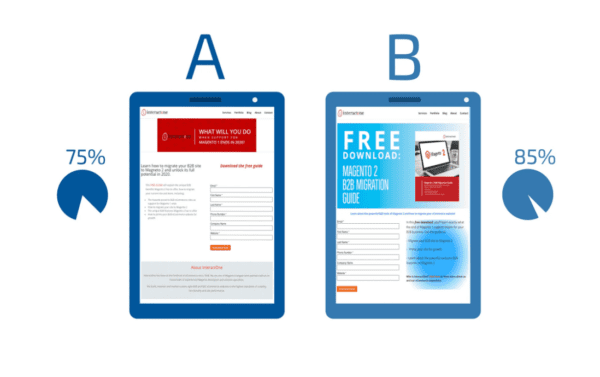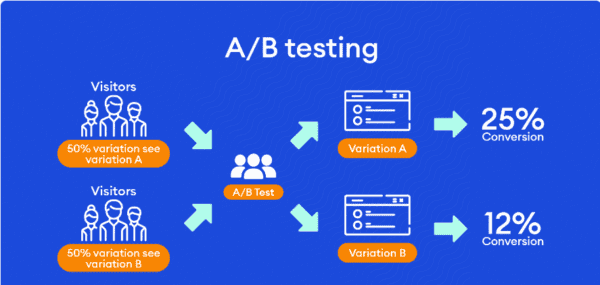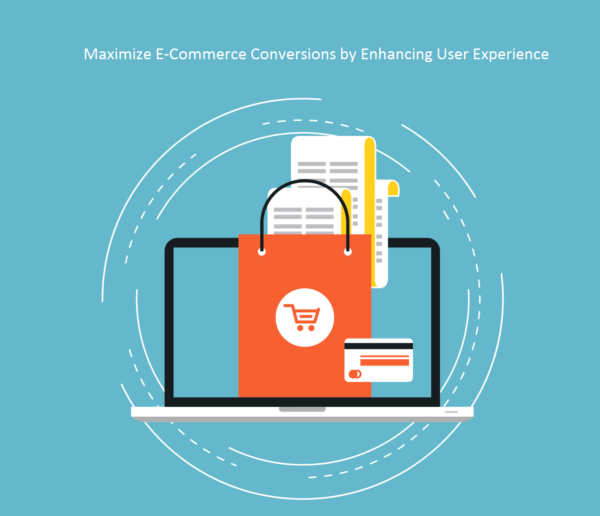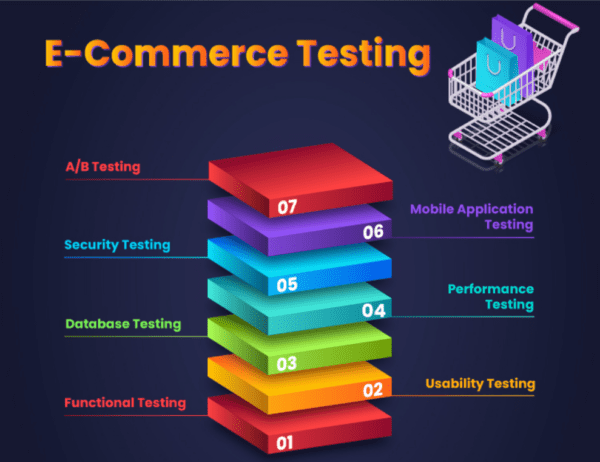Table of Contents
If you’re running an e-commerce website, you know that maximizing conversions is critical to your success. But how do you know which elements of your site drive sales and which turn people away? That’s where e-commerce A/B testing comes in. By testing different versions of your site against each other, you can identify which elements are most effective at driving conversions and optimize your site accordingly.
E-commerce A/B testing involves creating two or more versions of a page on your site and then randomly showing each version to different visitors. By tracking which version leads to more conversions, you can determine which elements are most effective at driving sales. This could include anything from the colour of your “Buy Now” button to the layout of your product pages.
Maximizing conversions on your e-commerce site can increase revenue and grow your business. A slight increase in your conversion rate can significantly impact your bottom line, and e-commerce A/B testing is one of the most effective ways to achieve that increase. So, if you’re not already testing different versions of your site, now is the time to start.

Fundamentals of E-Commerce A/B Testing
When it comes to e-commerce websites, maximizing conversions is crucial to the success of your business. One effective way to achieve this is through A/B testing, which involves comparing two versions of a webpage or element to determine which performs better. In this section, we will discuss the fundamentals of e-commerce A/B testing.
Understanding A/B Testing
A/B testing involves creating two versions of a webpage or element, with one being the control and the other being the variation. The power is the original version, while the variation is the modified version. The two versions are then presented to a random sample of visitors, and their behaviour is analyzed to determine which version performs better.
Importance of Statistical Significance
Statistical significance measures the reliability of the results obtained from an A/B test. It is essential to ensure that the results are not due to chance. The level of statistical significance required for an A/B test depends on various factors, such as the sample size, the difference between the two versions, and the necessary level of confidence.
Choosing the Right Sample Size
Choosing the right sample size is crucial to the success of an A/B test. The sample size should be large enough to ensure the results are statistically significant. However, it should not be too large, as this can lead to unnecessary expenses and delays in getting results. The sample size required for an A/B test depends on various factors, such as the necessary level of confidence, the size of the effect being tested, and the variability of the data.
In conclusion, A/B testing is an effective way to maximize conversions on e-commerce websites. By understanding the fundamentals of A/B testing, such as statistical significance and sample size, you can ensure that your tests are reliable and produce meaningful results.

Optimizing E-Commerce Website Design
Regarding e-commerce website design, several factors can affect your conversion rate. To optimize your website design for maximum conversions, you need to pay attention to the following factors:
Effective Layouts and Placement
The layout and placement of your website elements can significantly impact your conversion rate. For example, placing your call-to-action buttons above the fold can increase visibility and encourage more clicks. Similarly, a grid-based layout can make your website look more organized and professional.
Colour and Image Use
The colours and images you use on your website can also affect your conversion rate. For example, warm colours like red, orange, and yellow can create a sense of urgency and encourage people to act. On the other hand, using cool colours like blue and green can make a sense of calmness and trust.
Regarding product images, it’s essential to use high-quality photos that show the product from multiple angles. Lifestyle images that show the product in use would be best, as this can help potential customers visualize themselves using it.
Optimizing Call-to-Action Buttons
Your call-to-action buttons are one of the most critical elements of your website, as they encourage people to take action. To optimize your call-to-action buttons, you should consider the following:
- Button size: Your buttons should be large enough to be easily clickable but not so large that they take up too much space on your website.
- Button colour: As mentioned earlier, using warm colours like red, orange, and yellow can create a sense of urgency and encourage people to take action.
- Button text: Your button text should be clear and concise and communicate what will happen when clicked. For example, “Add to Cart” is a clear and concise button text for an e-commerce website.
By paying attention to these factors and optimizing your e-commerce website design accordingly, you can increase your conversion rate and maximize your profits.

Maximizing Conversion Through User Experience
Improving user experience is crucial to maximizing conversions in e-commerce A/B testing. Personalizing the shopping experience, streamlining the checkout process, and enhancing product pages can increase customer satisfaction and sales.
Personalization Strategies
Personalizing the shopping experience can increase customer engagement and loyalty. By tailoring your website to each customer’s preferences and behaviour, you can make them feel valued and more likely to purchase. Some personalization strategies include:
- Recommendation Engines: Use data to recommend products based on a customer’s browsing and purchase history.
- Dynamic Content: Show personalized content based on a customer’s location, device, or referral source.
- Targeted Emails: Send personalized emails with product recommendations or promotions based on a customer’s behaviour.
Streamlining the Checkout Process
A complicated checkout process can lead to cart abandonment and lost sales. Streamlining the checkout process can make it easier and faster for customers to complete their purchases. Some checkout process optimization strategies include:
- Guest Checkout: Allow customers to checkout without creating an account.
- One-Page Checkout: Simplify the checkout process by condensing it onto one page.
- Progress Indicators: Show customers how far along they are in the checkout process.
Enhancing Product Pages
Product pages are where customers make their final decision to purchase a product. By optimizing your product pages, you can increase the likelihood of a sale. Some product page optimization strategies include:
- High-Quality Images: Use high-quality images that show the product from multiple angles.
- Detailed Product Descriptions: Provide detailed product descriptions that answer common customer questions.
- Social Proof: Use customer reviews and ratings to show that other customers have had positive experiences with the product.
By utilizing these user experience optimization strategies, you can increase customer satisfaction and ultimately drive more sales.

Data-Driven Decision Making in E-Commerce
As an e-commerce business owner, you know the importance of maximizing conversions. One way to achieve this is through data-driven decision-making. By leveraging key metrics and analytics, you can gain valuable insights into customer behaviour and preferences, ultimately leading to increased sales. This section will discuss the importance of data-driven decision-making in e-commerce and how it can help you optimize your website for maximum conversions.
Key Metrics and Analytics
You need access to the correct data to make informed decisions. You can gain valuable insights into how your customers interact with your website by tracking key metrics such as conversion rates, bounce rates, and average order value. This data can help you identify areas for improvement and make data-driven decisions to optimize your site for maximum conversions.
Analytics tools such as Google Analytics can provide detailed reports on user behaviour, traffic sources, and more. By analyzing this data, you can better understand your customers and their preferences, allowing you to tailor your website to their needs.
Leveraging AI for Enhanced Insights
Artificial intelligence (AI) is becoming increasingly important in e-commerce. By leveraging AI-powered tools such as chatbots and recommendation engines, you can provide your customers with a personalized experience that drives conversions.
AI can also quickly and accurately analyze large amounts of data, providing enhanced insights into customer behaviour. Using AI-powered analytics tools, you can identify patterns and trends that may not be immediately apparent, allowing you to make data-driven decisions that optimize your website for maximum conversions.
Integrating Customer Feedback
Another critical component of data-driven decision-making is customer feedback. You can gain valuable insights into their preferences and pain points by soliciting customer feedback through surveys, reviews, and other channels.
Integrating customer feedback into your decision-making process can help you identify areas for improvement and make data-driven decisions that optimize your website for maximum conversions. By listening to your customers and acting on their feedback, you can build a loyal customer base that drives long-term success.
In conclusion, data-driven decision-making is essential for e-commerce businesses looking to maximize conversions. By tracking key metrics, leveraging AI-powered tools, and integrating customer feedback, you can gain valuable insights into customer behaviour and preferences, allowing you to optimize your website for maximum conversions.

Advanced Testing Strategies for E-Commerce
Regarding e-commerce, A/B testing is a well-known method for optimizing your website and maximizing conversions. However, other testing strategies can take your optimization efforts to the next level. This section will discuss some advanced testing strategies you can use to improve your e-commerce website.
Multivariate Testing vs A/B Testing
While A/B testing is the most commonly used testing strategy in e-commerce, multivariate testing can provide more detailed insights into your website’s performance. With multivariate testing, you can test multiple variables simultaneously, showing how different combinations of variables affect your conversion rates. This can be particularly useful when you have many variables to test, as it can save you time and resources.
Segmentation and Targeted Testing
Segmentation divides your audience into smaller groups based on specific criteria, such as demographics or browsing behaviour. By segmenting your audience, you can create more targeted tests designed to appeal to particular groups of people. This can help you identify which elements of your website are most effective for different segments of your audience and optimize your website accordingly.
Long-Term Testing and Future Trends
While short-term testing can provide valuable insights into your website’s performance, it is also essential to consider long-term testing. By testing over a longer period, you can identify trends and patterns in your audience’s behaviour, making more informed decisions about optimizing your website in the future. Additionally, it is essential to stay up-to-date with future trends in e-commerce, such as new technologies and changing consumer behaviours, to stay ahead of the competition.
In conclusion, there are many advanced testing strategies that you can use to improve your e-commerce website. By using multivariate testing, segmentation, and long-term testing, you can gain valuable insights into your audience’s behaviour and optimize your website accordingly. Additionally, it is essential to stay up-to-date with future e-commerce trends to stay ahead of the competition.

Measuring Success and Scaling Up
Once you have run your A/B tests, measuring success and scaling up your efforts is essential. Here are some critical steps to ensure you get the most out of your A/B testing efforts.
Interpreting Test Results
Interpreting test results is crucial to understanding what worked and what didn’t. Look at the data to see which variation performed better. Did it increase sales or revenue? Did it improve your conversion rate optimization (CRO)? Did it increase your average order value (AOV)? Analyzing these metrics will help you determine which variation is the winner.
Calculating ROI and Revenue Impact
Calculating ROI and revenue impact is essential to understanding the financial implications of your A/B testing efforts. You need to know how much revenue you generated from the winning variation, how much it cost to run the test, and the resulting ROI. This information will help you determine the success of your A/B testing efforts and help you justify the cost of running future tests.

Best Practices for Continuous Improvement
Continuous improvement is essential to maximizing the effectiveness of your A/B testing efforts. Here are some best practices to keep in mind:
- Test regularly: Testing regularly will help you stay on top of market changes and keep your website optimized for conversions.
- Focus on the user experience: Always keep the user experience in mind when running A/B tests. Make sure you are improving the user experience and not just trying to increase revenue.
- Test one variable at a time: Testing one variable at a time will help you isolate the impact of each change and make more informed decisions.
- Keep track of your results: Keeping track of your results will help you identify trends and patterns in your data and help you make more informed decisions.
Following these best practices can improve your website’s performance and maximize conversions.







